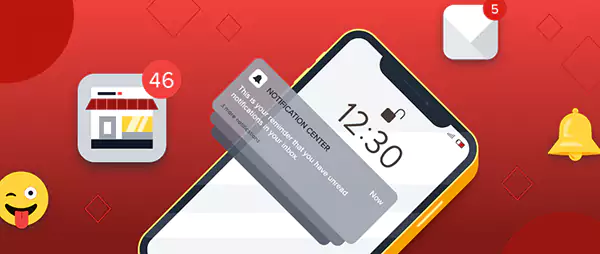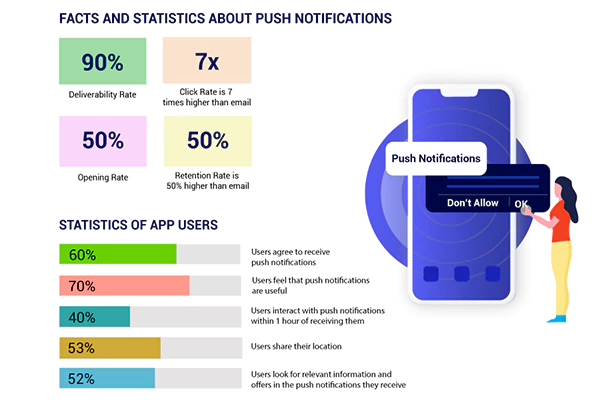
It’s 2024 and we all have smartphones in our hands these days.
Back in the day, notifications were seen as annoying messages that apps used to send out random messages in, but that’s not the case anymore.
A push notification is one of the most powerful communication tools that developers and digital marketers use to engage their users, promote their products, or create a better and more cohesive user experience.
While pushing impersonal and spammy notifications to the user’s devices may annoy them, sending them well-timed and personalized notifications can create a more positive and seamless experience that they’ll love.
So, if you’re a digital marketer or a developer looking to take your push notification game to the next level, keep on reading.
In this article, we will tell you about the best practices that industry experts use to send out push notifications that hit the mark every time.
So, before you start sending in notifications to your users, you need to get a better understanding of your users, their habits and preferences, etc.
You need to create content that sits well with them.
The bottom line is that to get the maximum impact with your push notifications, you need to focus on what your audience wants.
Well, you’re lucky in that area at least, with the help of data collection, analysis, and feedback, you can customize and create more personalized messages that will feel more relevant and engaging to your users.
DID YOU KNOW?
In an analysis done by OpenSignal of over 90 billion notifications sent in over 4 weeks, push notifications that targeted specific groups or segments had a 21% higher click-through rate than other random notifications.
Well, it’s not all about what you say that matters. To reap the real benefits of push notifications, you need to master the timing of when you say it too.
Your app can have users from across the world, living in different time zones, and having different hobbies, likes, and preferences. Sending your messages at the right time can bring about a dramatic increase in user engagement.
You can use intelligent delivery systems to optimize your notification delivery times when you think your users are more likely to open them.
While timing your notifications perfectly may help increase their engagement, it’s not enough if the content is just some random string.
The content of your notifications should always be the focus in any of your marketing strategies.
You should always test your content to see which ones are sitting well with your audience and also think about creating compelling headlines that can grab their attention with just a few lines.
Here are some tips to help you avoid some common design mistakes for your push notification content:
Plus, messages with exclusivity and urgency like some limited-time offers and sales are more likely to get user interaction than some random generic message would.
You need to make each message feel more personal and attention-grabbing.
So, take advantage of all the space and make your every word count.
Hey, it’s the numbers game out in the world of push notifications.
You need to understand that it’s not just your app alone that the user has on their devices. Too many notifications and you risk annoying the user and too few and your app might just be forgotten.
So, how do you find the best number of notifications to send before it gets annoying?
Well, the trick here is to find some middle ground. Keep track of your notification and engagement frequency and adjust the number accordingly.
Also, giving your users some form of control over what kinds of notifications they want to receive will only paint your app in a more positive image.
Rich notifications give you the power to add images, short videos, action buttons, and icons to your notifications.
Since not all of the users will click on your notifications, getting your point across with eye-catching images and videos will help boost the app’s engagement.
And while rich notifications are not always the answer, they can be pretty powerful tools.
Also, according to a recent study, we found that push notifications sent with images had a 60% higher chance of click-through than those without.
Also, to take your marketing game to another level, try employing a dynamic strategy.
Here are some key points to remember to boost your app’s engagement rates.
Besides just sending the right messages, your main goal throughout this process is to connect with your users and customize your notifications according to their needs.
User experience should be the first thing on your mind when you design your app.
You need to make sure that mobile users can easily opt-in or out of receiving your notifications.
Telling them outright how you plan to use their data can help your app build trust and ensure compliance with privacy regulations.
you need to always keep the user’s comfort and convenience as your top priority.

Push notifications are not all about pushing random messages to your users, it’s about creating meaningful and engaging interactions.
By understanding your audience, timing your messages right, crafting compelling content, and continually refining your strategy based on user feedback and data, you can transform your push notifications into a powerful engagement tool.
The key is to add value to your users’ lives, not just their notification trays.
